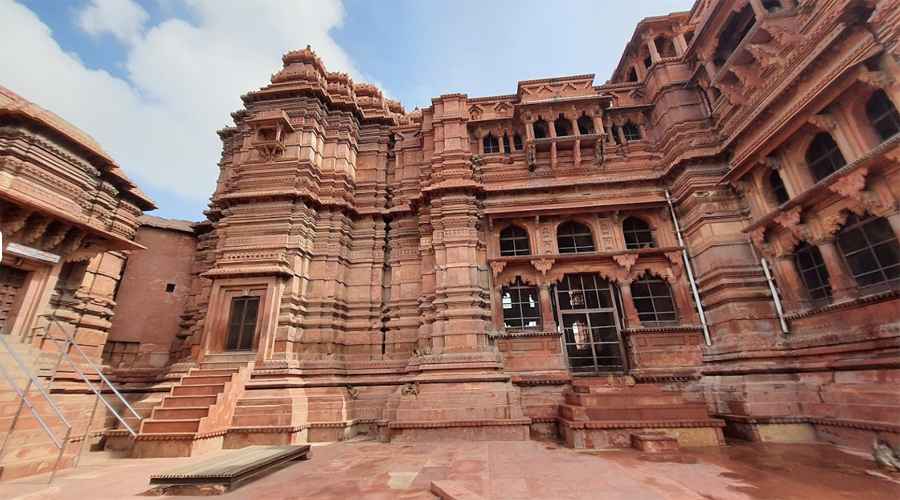Jaipur, the Pink City, is not only famous for its royal palaces and majestic forts but also for its deeply rooted spiritual and cultural heritage. Among its many revered temples, the Thikana Mandir Sri GovindDevJi holds a special place in the hearts of devotees. Dedicated to Lord Krishna, this temple is one of the most significant Vaishnavite shrines in North India and attracts thousands of pilgrims every year.
The idol of Lord Govind Dev Ji is believed to resemble the exact form of Krishna during his incarnation on Earth, making it a deeply cherished place of worship. The temple reflects the devotion of the Jaipur royal family as well as the vibrant traditions of Rajasthan.
Historical Background
The origins of the GovindDevJi temple are associated with the Vrindavan temples founded by the great saint Srila Rupa Goswami, a prominent disciple of Sri Chaitanya Mahaprabhu. The original idol of Lord GovindDevJi was discovered in Vrindavan in the 16th century. Later, due to threats of Mughal invasions, the idol was moved to Jaipur by Raja Sawai Jai Singh II, the founder of Jaipur, in the early 18th century.
Raja Jai Singh II was a devout follower of Lord Krishna and built a grand shrine in the heart of his new capital to enshrine the sacred image. Since then, Thikana Mandir GovindDevJi has remained the spiritual epicenter of Jaipur, intimately linked with the royal patronage of the Kachwaha dynasty.
Architectural Splendor
The temple of GovindDevJi showcases a unique blend of Rajasthani, Mughal, and traditional Hindu architecture. Constructed within the City Palace complex, the temple faces the royal Chandra Mahal, which allowed the king and his family to have a direct view of the deity from their palace.
Key architectural features include:
- Open courtyards where devotees gather for darshan.
- Intricate marble and red sandstone work highlighting the craftsmanship of Jaipur artisans.
- Arched gateways and high-ceiling halls inspired by Mughal styles.
- Spacious pradakshina paths where pilgrims take circular parikrama around the deity.
This architectural marvel not only reflects devotion but also the artistry of Jaipur’s golden era.
Spiritual Significance
Sri Govind Dev Ji is worshipped as the deity of Jaipur city and considered the protector of the people. The idol, believed to have been personally carved under the guidance of Rupa Goswami, is said to closely match the description of Krishna as seen by Srimati Radharani in Vrindavan.
The temple draws thousands of devotees daily, who come to seek blessings for prosperity, happiness, and spiritual upliftment. For Vaishnavites, it is one of the most sacred temples after Vrindavan and is counted among the seven prominent temples of Thakur Ji in Jaipur.
Daily Rituals and Darshan
One of the most unique aspects of the Thikana Mandir GovindDevJi is its seven daily darshans. Each darshan presents the deity in different attire and moods representing phases of the day in Krishna’s life. The aartis and bhajans sung by devotees and priests fill the temple with a divine atmosphere.
The seven darshans are:
- Mangala Aarti – early morning divine awakening of the Lord.
- Shringar Darshan – adorning the deity with ornaments and garments.
- Rajbhog Darshan – offering the grand feast to the Lord.
- Utthapan Darshan – waking the Lord after afternoon rest.
- Bhog Darshan – evening food offering with devotional chants.
- Sandhya Aarti – evening prayers with lamps and kirtans.
- Shayan Darshan – concluding darshan before Lord’s rest.
The experience of participating in these darshans is deeply blissful, connecting devotees with Krishna’s leelas and eternal presence.
Festivals at GovindDevJi Temple
The temple livens up during important Hindu festivals, attracting an ocean of devotees.
- Janmashtami: Celebrated with grandeur, marking the birth of Lord Krishna with midnight aarti, bhajans, and cultural programs.
- Holi: The temple becomes the center of vibrant celebrations with flowers, colors, and devotional music.
- Diwali & Kartik Purnima: The shrine glows with countless diyas, creating a mesmerizing sight.
- Radhashtami: Special darshan dedicated to Srimati Radharani, the eternal consort of Krishna.
These festive occasions not only deepen devotion but also showcase the rich cultural essence of Jaipur’s Vaishnav traditions.
How to Reach Thikana Mandir GovindDevJi
The temple is centrally located in the City Palace complex, Jaipur, making it easily accessible.
- By Air: Jaipur International Airport (11 km) is the nearest airport.
- By Train: Jaipur Junction railway station is around 6 km away.
- By Road: The temple is easily reachable through local transport, cabs, and buses within the city.
Its prime location ensures that pilgrims and tourists can conveniently combine their temple visit with other major attractions like Hawa Mahal, Jantar Mantar, and the City Palace.
Visitor Information
- Darshan Timings: Vary throughout the day based on the seven darshans; typically from 4:30 AM to 11:30 AM and 5:00 PM to 9:30 PM (may vary during festivals).
- Entry Fee: Free for all devotees.
- Best Time to Visit: Janmashtami and Kartik months see special celebrations but early morning darshan on regular days is also considered highly auspicious.
Visitors are expected to dress modestly and follow temple decorum during darshan and ceremonies.
Nearby Attractions
When visiting GovindDevJi temple, tourists often explore nearby landmarks such as:
- City Palace – the majestic royal residence.
- Hawa Mahal – Jaipur’s iconic “Palace of Winds.”
- Jantar Mantar – UNESCO World Heritage site with astronomical instruments.
- Albert Hall Museum – Rajasthan’s oldest museum.
This combination makes the temple visit both a spiritual and cultural experience.
Conclusion
The Thikana Mandir Sri GovindDevJi in Jaipur is more than just a place of worship. It is a living heritage where devotion, art, and history meet. The temple continues to preserve the Krishna bhakti traditions started by the Gaudiya Vaishnav saints while being closely tied to the legacy of Jaipur’s royal family. For devotees and travelers alike, visiting this temple is an unforgettable experience filled with divine grace, cultural richness, and spiritual peace.


